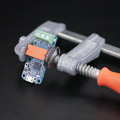Performance improvement of our API
 This week, we are going to talk again about our programming libraries, to announce a good news: We added an optimization which reduces running time by about 40% and splits by half the quantity of transferred data.
This week, we are going to talk again about our programming libraries, to announce a good news: We added an optimization which reduces running time by about 40% and splits by half the quantity of transferred data.
| No comment yet | Read more... |
How to get started in C# with Yoctopuce modules
![]() This week, we show you how to make a Windows application using Yoctopuce modules, in C#. The exercise is interesting because most C# examples provided with the Yoctopuce API are actually console applications. Windows Forms applications introduce some small differences which you should note. Note also that this post doesn't pretend to teach you C# programming. You are supposed to have some knowledge of it already :-)
This week, we show you how to make a Windows application using Yoctopuce modules, in C#. The exercise is interesting because most C# examples provided with the Yoctopuce API are actually console applications. Windows Forms applications introduce some small differences which you should note. Note also that this post doesn't pretend to teach you C# programming. You are supposed to have some knowledge of it already :-)
| No comment yet | Read more... |
Fancy ringtones for the Yocto-Buzzer
 The Yocto-Buzzer is a small module enabling you to provide an acoustic ack to the user, which is particularly useful when you work with a mini-computer without a soundcard or when you work remotely through the network. To ease the use of the Yocto-Buzzer, today we present a simplified method to generate short jingles.
The Yocto-Buzzer is a small module enabling you to provide an acoustic ack to the user, which is particularly useful when you work with a mini-computer without a soundcard or when you work remotely through the network. To ease the use of the Yocto-Buzzer, today we present a simplified method to generate short jingles.
| No comment yet | Read more... |
Multithreading and Yoctopuce libraries
 We take great care of our programming libraries, in particular of their ease of use. However, there is one spot where our libraries can be tricky: using our libraries from several threads. This week, we clarify and improve the situation.
We take great care of our programming libraries, in particular of their ease of use. However, there is one spot where our libraries can be tricky: using our libraries from several threads. This week, we clarify and improve the situation.
| No comment yet | Read more... |
How to start in Python with Yoctopuce modules
![]() This week, we explain to people using Yoctopuce modules for the first time how to manage them with a Python program through a relatively simple but realistic example. Obviously, we assume that the said people have at least some idea of Python programming, but we explain everything else in details.
This week, we explain to people using Yoctopuce modules for the first time how to manage them with a Python program through a relatively simple but realistic example. Obviously, we assume that the said people have at least some idea of Python programming, but we explain everything else in details.
| No comment yet | Read more... |
1 ... 10 ... 20 ... 30 ... 40 ... 50 ... 60 ... 70 ... 80 ... 86 87 88 89 90 91 92 93 94 95 96 ... 100 ... 110 ... 120 ... 130 ... 140 ... 150


